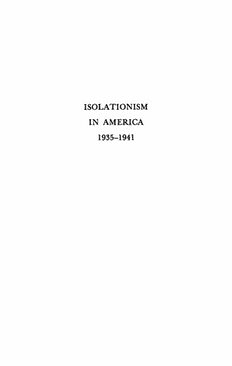
Isolationism in America, 1935-1941 PDF
Preview Isolationism in America, 1935-1941
ISOLATIONISM IN AMERICA 1935-1941 ISOLATIONISM IN AMERICA 1935-1941 By Manfred Jonas CORNELL UNIVERSITY PRESS Ithaca, New York Copyright © 1966 by Cornell University All rights reserved CORNELL UNIVERSITY PRESS First published 1966 Library of Congress Catalog Card Number: 66-16289 PRINTED IN THE UNITED STATES OF AMERICA BY W. F. HUMPHREY PRESS BOUND BY VAIL-BALLOU PRESS, INC. To Nancy PREFACE AMERICAN isolationism before the Second World War has deservedly been the subject of careful scrutiny in recent years. The anomaly of a great nation in the twentieth cen tury intently avoiding responsibility for world events, and striving to insulate itself by domestic legislation against dis asters it was unwilling to help prevent, has been treated from complementary viewpoints in Robert E. Osgood’s Ideas and Self-Interest in American Foreign Relations (1953) and Selig Adler’s The Isolationist Impulse (1957). It also received con siderable attention in Isolation and Security (1957), edited by Alexander De Conde. The “battle against isolation” is described in great detail both in The Challenge to Isolation, 1937-1940 (1952) by William L. Langer and S. E. Gleason, and in Donald F. Drummond’s The Passing of American Neutrality, 1937-1941 (1955). The controversy over neutrali ty legislation is examined by Robert A. Divine in The Illu sion of Neutrality (1962). Wayne S. Cole has treated one of the principal isolationist organizations in America First (1953) and one of the leading isolationist spokesmen in Senator Gerald P. Nye and American Foreign Relations (1962). No attempt has been made here to go over in detail the Vll viii Preface ground covered in these studies. Nor is it the purpose of this work to utilize the conclusions they offer for a synthesis that might try to be the definitive historical treatment of iso lationism in the thirties. Instead, this analysis seeks to define an aspect of isolationism previously glossed over or com pletely ignored. Nowhere in the works cited, nor in any others dealing with this subject, is the nature and content of isolationist thought adequately described, nor are its basic assumptions carefully examined. This is an effort to remedy the lack. The isolationist viewpoint, as expressed from 1935 to 1941, cannot be elevated to the level of political philosophy, yet it cannot be dismissed as simple obstructionism based on ignorance and folly. Isolationism was the considered response to foreign and domestic developments of a large, responsible, and respectable segment of the American people. This re sponse can be understood and evaluated only by examining the validity of the assumptions on which it was based. By extracting these basic premises from the mass of iso lationist letters, speeches, and writings and examining them in the light of the events to which they were applied, one can go far in explaining not only the survival of isolationism until the attack on Pearl Harbor, but also its subsequent disappearance. Because so many persons, knowingly or not, have helped to make this book possible, I can specifically acknowledge only my major indebtednesses. The task of collecting the necessary material was made less arduous through the generous assis tance provided by the staffs of the Franklin D. Roosevelt Library, the Yale University Library, the library of the John F. Kennedy-Institut at the Free University of Berlin, the Peace Collection of the Swarthmore College Library, the Manuscript Division of the Library of Congress, the Legis- Preface ix lative Records Division of the National Archives, and, above all, the Harvard University Library. I am indebted to the Honorable Ralph R. Roberts, Clerk of the U.S. House of Representatives, for permission to examine the records of various House committees and to the Honorable Leo W. O’Brien, M.C., for securing this permission for me. Arthur M. Schlesinger, Jr., encouraged me to undertake this project and throughout its earlier stages contributed suggestions and advice that have proved invaluable. Frank Freidel and Ernest R. May of Harvard University, and my colleague in Berlin, Ursula Brumm, read the original manu script and offered much-needed criticism. The perceptive judgment of Donald Fleming of Harvard University aided me in eliminating various errors and inconsistencies, though he is in no way responsible for those that may remain. I owe a special debt of gratitude to Bernard Roshco, who graciously gave of his time and talent. The nimble fingers and cheerful goodwill of Nancy Petersen Gibbons were essential to the final preparation of the manuscript. Grants from the Penrose Fund of the American Philo sophical Society and from the Union College Faculty Re search Fund made the completion of this book possible. My heaviest obligation is to my wife, Nancy Greene Jonas, whose contributions are too varied to permit enumeration here, and who bore the strains involved in the preparation of this book with fortitude, if not always with patience. M. J. Schenectady, New York August, 1965
